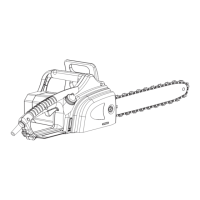1). Make sure the chain brake level is disengaged; (See Fig.
17a)
2). Place the chain saw on any suitable flat surface.
3). Plug the unit into the power source;
4). Grasp the front handle with your left hand. Thumb and
fingers should encircle the handle;
5). Grasp the rear handle with your right hand. Thumb and
fingers should encircle the handle;
6). Press the lock-off button with your right thumb, then fully
press the switch trigger with your index finger and hold in
this position;
7). While the motor is running, activate the chain brake level
by rolling your left hand forward against the chain brake
level; (See Fig. 17b)
8). Chain and motor should stop immediately.
NOTE: The motor will not start if the chain brake level is in
the engaged position.
Fig. 17a
Fig. 17b
CAUTION! The chain brake level should not be
used for starting and stopping the saw during normal
operation.
Kickback is the sudden backward/upward motion of the
chain saw, occurring when the chain (at the tip of the chain
bar) comes in contact with a log or wood, or when the chain
becomes jammed.
When kickback occurs the chain saw reacts unpredictably
and can cause severe injuries to the operator or bystanders.
Particular attention must be given when sawing sideward,
slanted or during length cuts, as the spiked bumper usually
can not be applied.
To avoid kickback:
- Saw with guide bar at a flat angle:
- Never work with a loose, widely stretched or the heavily
worn out chain:
- Ensure chain is sharpened correctly:
- Never saw above shoulder height:
- Never work with the tip of the guide bar:
- Always hold the chain saw firmly with both hands:
- Always use a low kickback chain:
- Apply the metal gripping teeth for leverage:
- Ensure correct chain tension:
5. KICKBACK. (See Fig. 18)
Fig. 18

